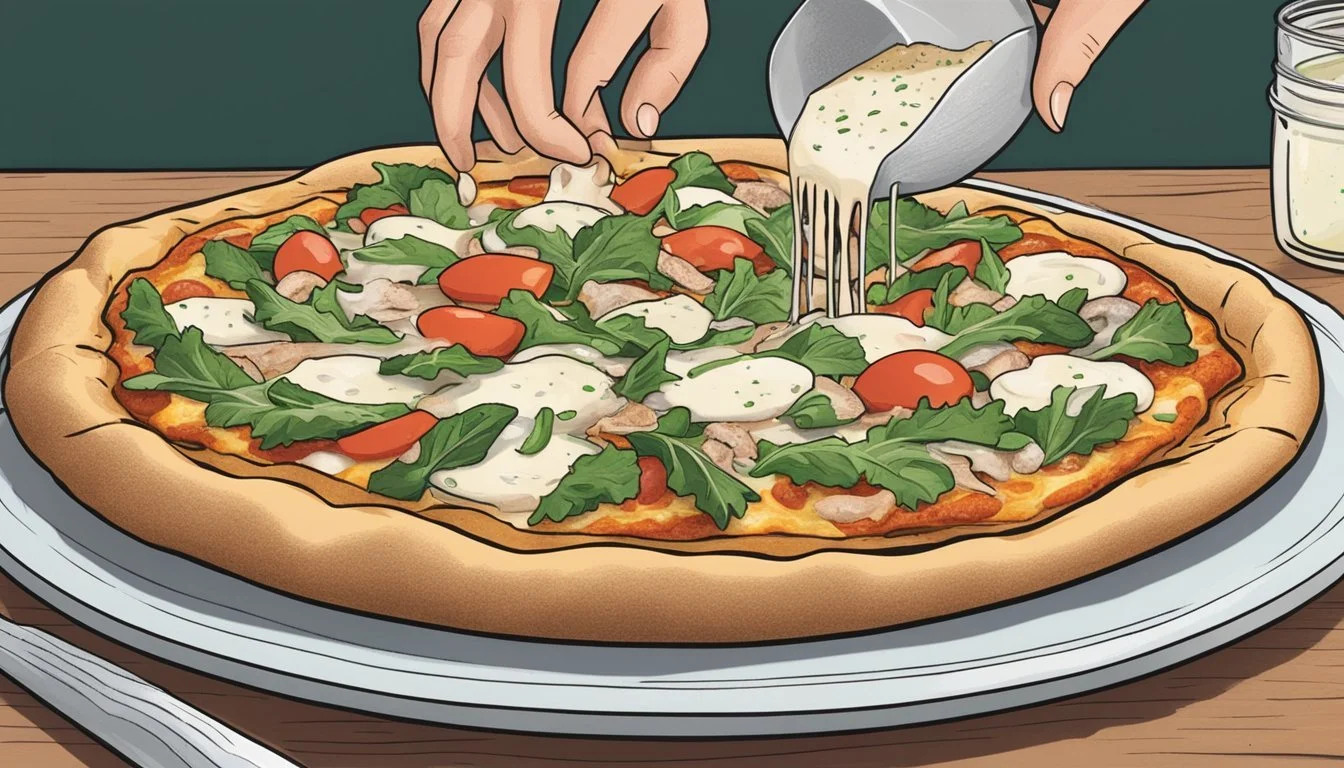Is Chicken Parmesan Ranch Pizza Vegan?
Debunking Common Myths
When exploring the question of whether chicken parmesan (What wine goes well with chicken parmesan?) ranch pizza (What wine goes well with pizza?) is vegan, it is critical to assess the ingredients typically involved in its preparation. Chicken parmesan ranch pizza, as the name suggests, includes chicken, parmesan cheese, and ranch dressing, all of which are standard non-vegan ingredients derived from animals. Parmesan cheese is made from cow's milk, and ranch dressing often contains mayonnaise and buttermilk, making it unsuitable for a vegan diet, which excludes all animal products.
The vegan diet consists of plant-based foods, excluding meat, dairy, and other animal-derived substances. While the traditional recipe for chicken parmesan ranch pizza is not vegan, some pizzerias might offer vegan alternatives that mimic the flavors and textures of the original dish. These establishments may use plant-based chicken substitutes, dairy-free cheese, and vegan ranch dressing made from non-animal ingredients to cater to those following a vegan lifestyle.
As veganism grows in popularity, an increasing number of restaurants are expanding their menus to include plant-based versions of classic dishes. Although not inherently vegan, chicken parmesan ranch pizza can be modified with alternative ingredients to fit a vegan dietary profile. Individuals interested in this option should look for venues that specifically advertise vegan choices and confirm the vegan status of the ingredients used in their meals.
Understanding Veganism
Veganism is the practice of foregoing all animal products, particularly in diet, to embrace a more ethical and often environmentally sustainable way of living. This section examines what constitutes a vegan product and explores common vegan substitutes.
Defining Vegan Products
Vegan products are those devoid of animal involvement, not merely the absence of meat. This includes dairy, eggs, and even honey. Vegan products must adhere to strict standards—no animal-derived ingredients or processing aids are acceptable. For those evaluating pizza for vegan suitability, the specifics matter: the crust, toppings, and cheese must all be plant-based.
Vegan Cheese: Traditional cheese is replaced with alternatives made from plant sources such as nuts, soy, or root vegetables.
Vegan Mozzarella: A subset of vegan cheese, often used on pizzas for a similar melt and stretch quality to dairy mozzarella, usually derived from cashews or coconut oil.
Dairy-Free: This term indicates a product contains no milk products, but it can sometimes include eggs, making careful assessment necessary to confirm its vegan status.
Common Vegan Substitutes
Vegan substitutes aim to replicate the taste and texture of their non-vegan counterparts while remaining plant-based.
Plant-Based Cheese: Ranges from slices and shreds to spreads and blocks. Ingredients like tapioca, pea protein, and various plant milks are key players.
Here is a concise comparison table for commonly used cheese substitutes:
Substitute Type Base Ingredient Common Use Nut-based Cheese Cashews, almonds Artisan slices, spreads Root Vegetable Cheese Potatoes, carrots Block cheeses, sauces Soy-based Cheese Soybeans, soy milk Shreds, slices, spreads
Identifying whether a product is vegan often requires a close inspection of food labels to spot hidden animal-derived ingredients.
Components of Chicken Parmesan Ranch Pizza
In this section, the focus is on dissecting the various elements that compose a Chicken Parmesan Ranch Pizza, highlighting the traditional ingredients used.
The Chicken Element
The chicken used in this pizza is typically either breaded and baked or fried to achieve a crispy texture. Boneless skinless chicken thighs (What wine goes well with chicken thighs?) or sliced breasts are dipped in egg, coated with a mixture of Panko breadcrumbs, possibly mixed with herbs and spices like garlic powder and onion powder, and Parmesan cheese, and then cooked until golden brown.
Pizza Crust Variations
A variety of pizza crusts can serve as a base for Chicken Parmesan Ranch Pizza, including thin crust to thick, hand-tossed styles. The recipe may call for pizza dough to be shaped into a large round (about 12 to 13 inches), potentially on parchment paper or in a pizza pan, with the option to brush the surface with olive oil for additional flavor.
Cheese Considerations
Cheese is a key component, usually involving a generous sprinkling of mozzarella cheese and Parmesan cheese over the sauce. However, for those considering vegan options, vegan mozzarella shreds can be used to mimic the stretchiness and melt of traditional cheese.
Ranch Dressing Dissection
Ranch dressing serves as the signature creamy sauce base for Chicken Parmesan Ranch Pizza. It combines herbs like garlic powder and onion powder along with a mayonnaise or buttermilk base to create a rich and tangy flavor profile. One would evenly spread the ranch dressing over the pizza crust, typically leaving a border for the outer crust.
Veganizing the Pizza
Making a chicken parmesan ranch pizza vegan involves finding plant-based substitutes for the chicken and cheese, creating a dairy-free ranch dressing, and ensuring that the pizza dough and toppings are free of animal products.
Substituting Chicken and Cheese
To replace chicken on a vegan pizza, one can use plant-based meat alternatives, such as those made from textured vegetable protein or seasoned tofu. Vegan mozzarella or cheeses crafted from nuts like cashews offer a great substitute for dairy cheese. Nutritional yeast can also be added for a cheesy flavor without the dairy.
Vegan Ranch Recipes
The classic ranch dressing can be made vegan by using dairy-free ingredients. A common vegan ranch recipe might include vegan mayonnaise, vegan sour cream, and a blend of herbs and spices. Non-dairy milk can be adjusted for desired consistency, and nutritional yeast may be added for extra flavor.
Dairy-Free Pizza Dough and Toppings
A vegan pizza crust typically contains flour, water, yeast, sugar, and oil. It's critical to ensure that the sugar is not processed with bone char, a non-vegan filtering process. Toppings for a vegan pizza can include a variety of vegetables, such as bell peppers, onions, olives, and spinach, all adding flavor and nutrition to the pizza.
Seasonings and Flavor Enhancers
Proper seasoning and flavor enhancements are essential for a vegan Chicken Parmesan Ranch pizza to mimic the depth and richness of its non-vegan counterpart.
Herbs and Spices
Herbs: The triumvirate of Italian cuisine—basil, oregano, and rosemary—is crucial in imbuing the pizza with its characteristic herby profile. The earthy tones of oregano and the sweet, minty notes of basil complement each other and are typically used as follows:
Basil: 1 teaspoon dried or 1 tablespoon fresh
Oregano: 3/4 teaspoon dried
Spices: Garlic and onion powders are staple spices that add a savory complexity to the pizza. Season with black pepper to introduce a slight heat and salt to enhance overall flavor.
Garlic Powder: 1/2 teaspoon
Onion Powder: 1/2 teaspoon
Salt: To taste
Black Pepper: 1/4 teaspoon ground
Creating Depth of Flavor
To create a rich flavor base without animal products, one must layer flavors meticulously. A combination of the prior mentioned herbs and spices, with precise salt levels, can enhance the tomato sauce and plant-based toppings, infusing the pizza with a full-bodied taste. Marinades for the vegan chicken substitute often include a mixture of spices and should be allowed to sit, ideally overnight, to fully absorb the flavors.
Depth can also be enhanced by browning ingredients, like vegan chicken, on the stove to introduce caramelization and umami notes. Using quality olive oil as a medium for carrying flavors is also an effective strategy to achieve a satisfying mouthfeel on a vegan diet.
Cooking Techniques
In preparing a vegan chicken parmesan ranch pizza, the baking technique is critical for achieving the perfect crust and melted cheese texture. Alternative methods can also yield delicious results, accommodating different kitchen equipment and preferences.
Baking Fundamentals
For a vegan chicken parmesan ranch pizza, one must preheat the oven, typically between 375°F (190°C) and 475°F (246°C), depending on the recipe specifics. It is essential to use a baking sheet or a pizza stone to ensure even heat distribution. A pizza stone should be placed in the oven during the preheating stage to get hot. When using a baking sheet, it's recommended to:
Lightly flour the surface before adding the pizza dough to prevent sticking.
Bake for an appropriate duration, usually between 13 to 20 minutes until the crust is golden and the toppings are properly heated.
Alternative Cooking Methods
Aside from the traditional oven baking, a microwave can be used for convenience, though it may not provide the same texture as oven-baking. For those without an oven, a microwave with a convection setting can serve as an alternative, being careful to:
Use microwave-safe cookware.
Adjust the cooking time to prevent overcooking the toppings.
Freezing the pizza is an option for meal prep, but it should be properly wrapped to avoid freezer burn. When ready to eat, the pizza can be thawed and then baked to restore its flavors and textures.
Customizing Your Vegan Pizza
Crafting a vegan pizza provides a delightful opportunity to explore a wide array of plant-based ingredients, ensuring a satisfying meal without any animal products. Pizza enthusiasts can curate their experience with carefully selected toppings and cheese alternatives for a delectable vegan creation.
Topping Combinations
When it comes to topping a vegan pizza, one should look for a variety of fresh veggie toppings. These might include:
Mushrooms: offering a meaty texture.
Onions: adding a sweet or sharp flavor depending on the type.
Black Olives: providing a salty and earthy note.
Spinach: bringing a subtle freshness to the pie.
Here are a few topping combinations a pizza maker may consider:
Classic Veggie: Mushrooms, onions, black olives, and a touch of spinach for greenery.
Mediterranean Twist: Diced tomatoes, artichoke hearts, red onions, and a sprinkle of capers (What wine goes well with capers?) alongside black olives.
Cheese and Sauce Pairings
The base of any good pizza often lies with the right sauce and cheese pairing. For vegans, traditional cheese is replaced with vegan mozzarella alternatives. The following pairings highlight plant-based adaptations of timeless favorites:
Marinara Sauce: A simple, robust tomato sauce that complements the meltability of vegan mozzarella.
Vegan Sauce Vegan Cheese Pairing Notes Marinara Sauce Vegan Mozzarella Classic and melts well.
BBQ Sauce: A tangy and sweet option that goes well with vegan cheddar and smoky toppings like vegan bacon bits.
Vegan Sauce Vegan Cheese Pairing Notes BBQ Sauce Vegan Cheddar Pairs with smoky flavors for a bold bite.
Pizza artisans should keep in mind that the success of a vegan pizza lies in balancing the flavors of their sauce with any chosen vegan cheese to deliver the true pizzeria experience, reimagined for the vegan palate.
Serving and Presentation
When preparing vegan chicken parmesan ranch pizza, presentation plays a pivotal role in enhancing the overall dining experience. Striking a balance between aesthetic appeal and maintaining the vegan integrity of the dish is crucial.
Completing the Meal
A side dish often complements the main course. Vegan chicken parmesan ranch pizza pairs excellently with a fresh garden salad. This salad acts not only as a refreshing palate cleanser but also ensures a balanced meal. For an ideal presentation:
Salad: A simple mix of leafy greens, cherry tomatoes, cucumbers, and shredded carrots. Dress with a light vinaigrette or lemon juice to maintain vegan standards.
Plating: Serve the salad on a separate dish or alongside the pizza to avoid sogginess.
Dipping Sauces and Sides
Dipping sauces enhance the flavor of vegan pizza. Options should remain dairy-free to align with a vegan diet:
Marinara Sauce: A classic choice, often seasoned with basil and oregano.
Hot Sauce: For those preferring a spicy kick, ensure it's free from animal by-products.
Vegan Ranch: Crafted from vegan mayonnaise and dairy-free milk, seasoned with garlic and onion powder, and a touch of vegan butter for richness.
For sides, one can opt for simple baked potato wedges or steamed vegetables lightly seasoned with herbs. Serving them on the side preserves their texture and complements the pizza.
Nutritional Information
This section details the caloric content and macronutrients of a typical Chicken Parmesan Ranch Pizza and contrasts it with the nutritional considerations of a vegan diet.
Counting Calories and Macros
Chicken Parmesan Ranch Pizza typically contains a combination of chicken, cheese, ranch dressing, and other toppings, all of which contribute to its total caloric value. A standard slice of this pizza variant would generally have the following nutritional makeup:
Calories: 221-300 per slice, varying by size and ingredients
Fat: 9-10g with a significant portion from cheese and ranch dressing
Protein: Predominately from chicken, amounts can vary
Carbohydrates: Present in the crust and sauce
This pizza is not vegan due to its dairy and meat components. Therefore, nutritional yeast is not applicable as it's often used as a cheese substitute in vegan diets.
Health Benefits of a Vegan Diet
A vegan diet eschews all animal products, often resulting in lower calorie intake and may provide a varied nutritional profile when well-planned. For example:
Calories: Generally lower as plant-based ingredients tend to have fewer calories than dairy and meat.
Nutritional Yeast: Provides protein, vitamins, especially B-vitamins, and is low in fat.
A vegan alternative to Chicken Parmesan Ranch pizza would include plant-based cheese and mock meats, with a significant reduction in saturated fats, relying on nutritional yeast and other vegan ingredients for flavor.
Exploring Vegan Pizza Varieties
In the evolving landscape of vegan cuisine, pizza emerges as a versatile dish with global influences and trendy establishments dedicated to meeting the demands of plant-based preferences.
Global Vegan Pizza Inspirations
Vegan pizza transcends borders, mingling flavors like buffalo and BBQ with the traditional Italian foundation. Innovators in Brooklyn have been pushing the envelope, introducing pies topped with zesty buffalo sauce and creamy vegan cheeses, while BBQ lovers can find smoked vegan meats drizzled with tangy BBQ sauce lying atop a golden crust.
Buffalo Vegan Pizza: Bold and spicy, often accompanied by dairy-free ranch or blue cheese dressing.
BBQ Vegan Pizza: Smokey and sweet, loaded with plant-based proteins and vegan BBQ sauce.
Additionally, gluten-free options abound, with crusts made from alternative flours to accommodate those with sensitivities, ensuring everyone can savor the diversity of vegan pizza.
Trendy Vegan Pizza Establishments
They're sprouting up in cities across the globe — trendy venues that elevate vegan pizza to a culinary art form. In Brooklyn, cutting-edge pizzerias serve as gastronomic havens, offering an array of vegan food. These establishments often boast:
Ingredient Quality: Fresh, locally-sourced toppings and homemade sauces.
Innovation: Creative combinations that challenge traditional pizza conventions.
Atmosphere: Spaces where foodies and the vegan-curious alike can gather and indulge with peace of mind.
Table 1: Featured Trendy Vegan Pizzerias and Their Signature Offerings
Pizzeria Location Signature Vegan Pizza Noteworthy Feature Pizzeria A Brooklyn Buffalo Cauliflower Pizza House-made cashew cheese Pizzeria B Brooklyn BBQ Jackfruit Feast Gluten-free crusts available
As the demand for vegan options grows, these restaurants continue to adapt and expand their menus, ensuring that vegan pizza remains an innovative and satisfying culinary choice.










